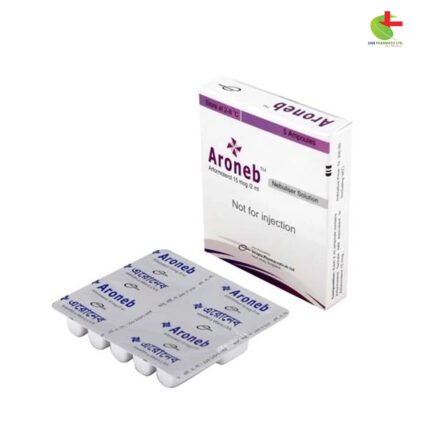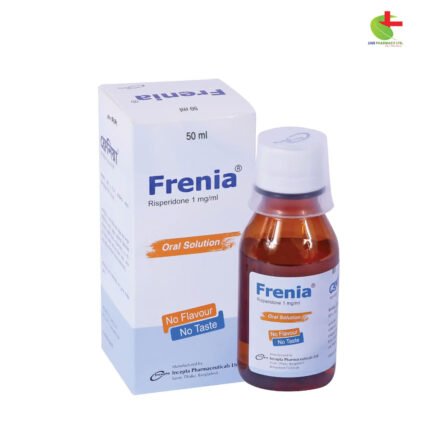Supotaria
150.00৳ Ampoule(5p)
- Glycopyrrolate nebulizer solution is a long-acting muscarinic antagonist indicated for the long-term maintenance treatment of chronic obstructive pulmonary disease (COPD), including chronic bronchitis and emphysema.
- It provides effective bronchodilation by inhibiting the M3 receptor in the airways.
- Administered via a high-efficiency mesh nebulizer, the recommended dosage is one ampoule twice daily.
- Patients should consult a healthcare professional before use and adhere to prescribed guidelines for safe administration.
 Brand
Brand
|
Incepta Pharmaceuticals Ltd |
|---|---|
 Generics
Generics
|
Glycopyrronium Bromide |
 Type
Type
|
Respirator Solution |
Indications
Glycopyrrolate nebulizer solution is prescribed for the long-term management of patients diagnosed with chronic obstructive pulmonary disease (COPD), including those with chronic bronchitis and/or emphysema.
Always use this medication as directed by a registered healthcare professional.
Pharmacology
Glycopyrrolate is classified as a long-acting muscarinic antagonist, exhibiting a comparable affinity for muscarinic receptor subtypes M1 to M5. Within the airways, it functions pharmacologically by inhibiting the M3 receptor found in smooth muscle, leading to effective bronchodilation.
Dosage & Administration
The Glycopyrronium nebulizer solution is exclusively for inhalation through a high-efficiency mesh nebulizer and must not be taken orally or administered via injection. The recommended dosage is to inhale the contents of one ampoule twice daily using the high-efficiency nebulizer. Patients should administer Glycopyrrolate at consistent times each day—one ampoule in the morning and one in the evening. Avoid exceeding the prescribed frequency (more than one ampoule twice daily).
Store the ampoules in their blister packaging, removing them only immediately prior to use. No dosage adjustments are necessary for elderly patients, those with liver impairment, or individuals with mild to moderate renal issues.
How to Use:
- Open the packet and remove the blister.
- Carefully detach one ampoule from the blister.
- Twist off the top while holding the ampoule upright.
- Squeeze the required amount of nebulizer solution into the nebulizer chamber.
- If dilution is necessary, follow your doctor’s instructions.
Always use this medication as directed by a registered healthcare professional.
Interactions
- Sympathomimetics and Steroids: Clinical studies indicate that concurrent use of Glycopyrrolate with other COPD treatments, including sympathomimetics (both long- and short-acting beta2 agonists), anticholinergics (short-acting antimuscarinic antagonists), and oral or inhaled steroids, does not significantly increase the risk of adverse reactions.
- Anticholinergics: There is a potential for additive effects when Glycopyrrolate is used alongside other anticholinergic medications. Therefore, avoid unnecessary co-administration to prevent heightened anticholinergic effects.
Contraindications
Glycopyrrolate is contraindicated in individuals with a known hypersensitivity to glycopyrrolate or any of its components, including Sodium Chloride, Citric Acid Monohydrate, Sodium Hydroxide, Hydrochloric Acid, and Water for Injection.
Side Effects
Potential adverse reactions may include:
- Shortness of breath
- Urinary tract infections
- Wheezing
- Upper respiratory tract infections
- Runny nose
- Fatigue
Pregnancy & Lactation
Adequate and well-controlled studies in pregnant women are lacking. Glycopyrrolate should only be used during pregnancy when the potential benefits outweigh any risks to the fetus. It is not recommended for use in pediatric patients.
Precautions & Warnings
- Do not initiate treatment during an acute exacerbation of COPD or for acute symptom relief.
- Discontinue the Glycopyrrolate nebulizer solution immediately if paradoxical bronchospasm occurs and seek alternative therapy.
- Patients with narrow-angle glaucoma should use Glycopyrrolate with caution and report any symptoms to their physician.
- Use caution in patients with prostatic hyperplasia or bladder neck obstruction, as urinary retention may worsen.
- As this product contains no preservatives, each ampoule should be used immediately after opening and not stored above 25°C.
Overdose Effects
An overdose of Glycopyrrolate may result in anticholinergic symptoms such as nausea, vomiting, dizziness, lightheadedness, blurred vision, increased intraocular pressure (which may cause eye pain, vision changes, or redness), obstipation, or difficulty voiding.
Therapeutic Class
Bronchodilator
Storage Conditions
Store in a cool, dry place below 30°C. Protect from light and keep out of reach of children.













Reviews
There are no reviews yet.